A 50 inch TV is a television with a screen size measured diagonally from one corner to the opposite corner. This size is popular for home entertainment, fitting well in most rooms. It offers a balance between screen size and space-saving design.
Thinking about the right TV size for your room? A 50 inch TV could be perfect for both small and large spaces. Its versatile size makes it a great choice for living rooms and bedrooms alike.
A 50 inch TV generally measures about 44-46 inches wide and 25-28 inches tall without the stand. These dimensions provide a comfortable viewing experience. With the right setup, it can transform your space into a home theater.
Understanding TV Measurements
When we talk about a “50 inch TV” we’re usually referring to its diagonal measurement, which is the distance from one corner of the screen to the opposite corner. This measurement, however, doesn’t tell the whole story when planning your room layout, choosing the right stand, or ensuring it fits within your entertainment center.
Key Measurement Points:
- Diagonal Size: The 50 inches in a 50 inch TV refers specifically to the screen’s diagonal length, measured from corner to corner.
- Width and Height: These dimensions depend on the TV’s aspect ratio. Most modern TVs have a 16:9 aspect ratio, which creates a rectangular, widescreen format ideal for HD content.
- Depth: This depends on the model and screen technology. The depth of a TV can impact wall mounting, furniture placement, and available space behind the TV for ventilation.
Understanding these points can help you make a more informed choice and visualize how the TV will look in your room.
TV Size to Distance Calculator and Science
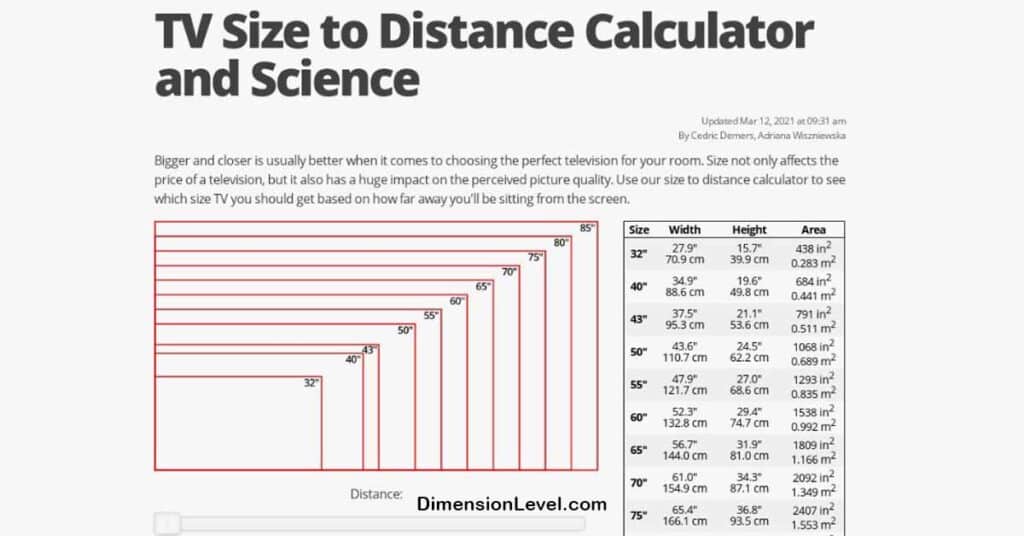
The Science Behind Viewing Distance
The ideal viewing distance is based on visual clarity and comfort. Studies show that sitting too close or far from a TV can reduce your ability to enjoy detail, especially with higher resolutions. For instance, a 4K TV allows for closer seating without visible pixelation, while a 1080p model requires slightly more distance for optimal viewing quality.
Factors in Calculating TV Viewing Distance:
- Screen Resolution: Higher resolutions like 4K and 8K have higher pixel densities, allowing for closer viewing without visible pixels.
- Field of Vision: A 30-40 degree viewing angle is recommended for an immersive experience, ensuring that the TV screen fills an adequate portion of your field of view.
- Eye Strain Reduction: Proper distance can prevent eye strain and make watching TV more comfortable over longer periods.
You Might Also Like 70 Inch TV Dimensions Width, Height, Depth (Easy Guide)
TV Size to Distance Calculator for a 50-Inch TV
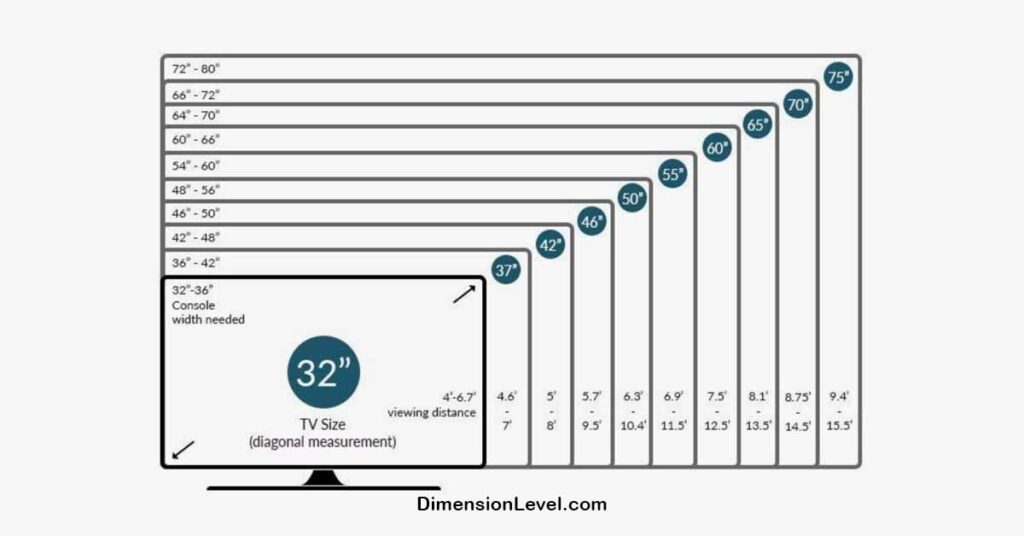
Using general guidelines, here’s the recommended distance for a 50 inch TV based on common resolutions:
| TV Resolution | Recommended Viewing Distance |
|---|---|
| 1080p | 6-8 feet |
| 4K UHD | 4-6 feet |
| 8K UHD | 3-4 feet |
These distances offer the best combination of image clarity and comfort, providing a sharper picture without visible pixels.
How Big is a 50 Inch TV in cm, Inches, and mm?
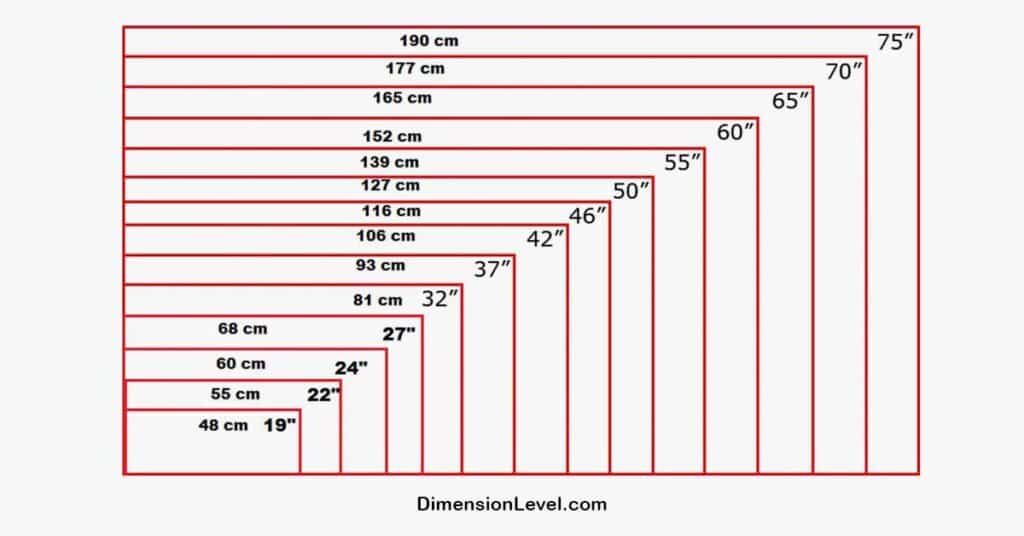
Converting TV dimensions into different units makes it easier to plan, especially when working with international measurements. Here’s a breakdown of the size in inches, centimeters (cm), and millimeters (mm):
| Measurement Type | Inches | Centimeters | Millimeters |
| Diagonal | 50 inches | 127 cm | 1270 mm |
| Width | 44-46 inches | 112-117 cm | 1120-1170 mm |
| Height | 25-28 inches | 63-71 cm | 630-710 mm |
These measurements can slightly vary based on the model, especially if it has a thick or thin bezel surrounding the screen.
You might be Interested 75 Inch TV Dimensions- Size, Width, Height (Easy Guide)
What is 50 Inches in Feet?
For reference, 50 inches is approximately 4.17 feet diagonally. This can be useful when comparing the TV size to other large furniture in your room, such as your couch, a coffee table, or even a bed.
Aspect Ratios and Their Impact
The aspect ratio refers to the ratio of the width to the height of the TV screen. Most modern TVs use a 16:9 aspect ratio, meaning the width is 1.77 times the height. This aspect ratio has become standard for HD, 4K, and even 8K TVs, providing a more immersive, cinematic experience.
Why Aspect Ratios Matter
- A wider aspect ratio means more screen space horizontally, ideal for movies and sports.
- TV dimensions are based on the aspect ratio, so a 50 inch TV with a 4:3 aspect ratio would have very different measurements than one with a 16:9 aspect ratio.
- For practical purposes, the 16:9 aspect ratio allows most 50-inch TVs to fit comfortably within the width and height of standard TV stands and wall mounts.
How Big is a 50 Inch TV in cm, Inches, and mm?
Here’s a breakdown of a typical 50 inch TV size in inches, centimeters (cm), and millimeters (mm):
| Measurement Type | Inches | Centimeters | Millimeters |
|---|---|---|---|
| Diagonal | 50 inches | 127 cm | 1270 mm |
| Width | 44-46 inches | 112-117 cm | 1120-1170 mm |
| Height | 25-28 inches | 63-71 cm | 630-710 mm |
These dimensions vary slightly by model due to differences in bezel and frame width, but they generally apply to most standard 50-inch TVs.
How Many Pixels Does a 50 Inch TV Have?
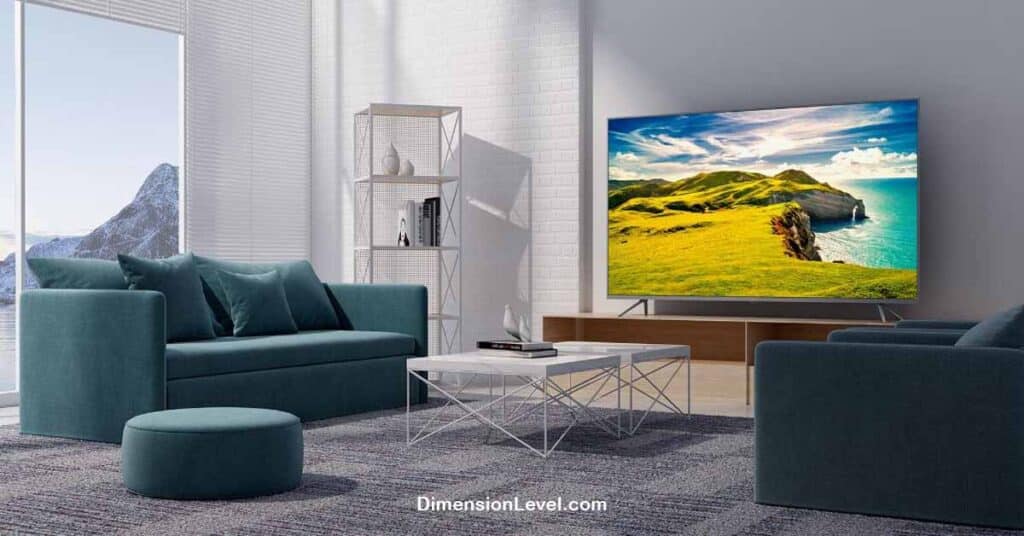
The resolution of a TV determines the number of pixels on the screen. A higher resolution means more pixels, which improves picture quality, especially when viewed up close. Here’s a quick look at common resolutions for 50 inch TVs:
- 1080p (Full HD): 1,920 x 1,080 pixels, which totals around 2 million pixels.
- 4K (Ultra HD): 3,840 x 2,160 pixels, resulting in approximately 8 million pixels.
- 8K Resolution: 7,680 x 4,320 pixels, boasting around 33 million pixels, though 8K is less common in 50-inch TVs.
Higher resolutions, such as 4K and 8K, allow for closer viewing distances without sacrificing picture quality, making them ideal for medium-sized rooms.
Explore this How Wide is a 60 Inch TV?
Standard 50 Inch TV Dimensions
While the exact size of a 50 inch TV varies slightly by model, here are the general dimensions for width, height, and depth:
Width of a 50 Inch TV
The width of a 50 inches TV is typically around 44 to 46 inches. This dimension ensures it fits well within most entertainment centers and on TV stands.
Height of a 50 Inch TV
Most 50 inches TVs have a height between 25 to 28 inches. This allows them to fit comfortably on a stand or wall-mounted without overwhelming a medium-sized room.
Depth of a 50 Inch TV
The depth of a TV varies based on its technology and model:
- LED TVs: 2-3 inches deep
- OLED TVs: 1-2 inches deep, providing an ultra-thin profile
- QLED TVs: 1.5-2.5 inches, balancing slim design with durability
Calculating TV Dimensions
If you’re curious about the exact width and height based on the diagonal size, here’s a simple calculation:
- Width: Diagonal size × 0.87
- Height: Diagonal size × 0.49
Applying this to a 50 inch diagonal:
- Width = 50 × 0.87 ≈ 43.5 inches
- Height = 50 × 0.49 ≈ 24.5 inches
Bezel and Frame Considerations
A bezel is the frame around the screen. Most modern TVs have a thin bezel, adding only about 0.5 to 1 inch to each side of the TV. Thinner bezels create a more immersive experience, as there’s less frame to distract from the screen.
Stand and Base Dimensions
Choosing a stable, compatible stand or base is essential for TV placement.
Weight Distribution and Stability
A 50 inches TV generally weighs 25-35 pounds. Choose a stand with adequate weight capacity, especially if you have children or pets who might jostle the setup.
Adjustable vs. Fixed Stands
Some stands offer adjustable height or tilt, allowing you to customize the angle and height for the best viewing experience. Fixed stands, however, are typically more robust and compact.
Wall Mounting a 50 Inch TV
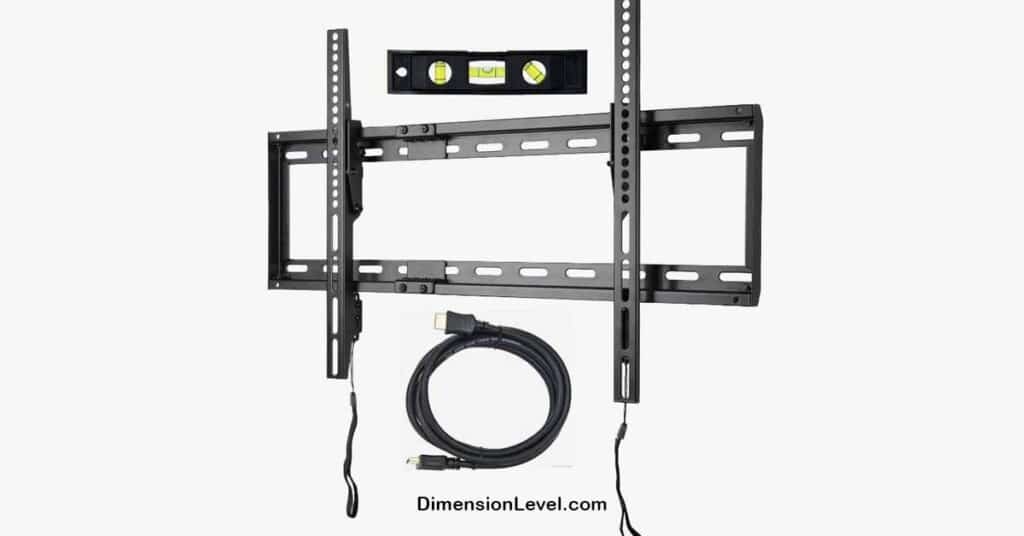
Wall-mounting a TV frees up floor space and creates a sleek look. Here are the most important factors to consider:
VESA Mount Sizes
The VESA mount size determines the hole pattern for mounting brackets. For 50 inch TVs, typical sizes include:
- 200×200 mm for smaller 50-inch TVs
- 400×400 mm for larger models
Clearance for Ports and Ventilation
Ensure there’s adequate clearance for ports and ventilation. A recommended 4-6 inches of clearance behind the TV allows for proper airflow, preventing overheating.
Optimal Viewing Height
The optimal height for a 50 inch TV is around 42-45 inches from the floor to the screen’s center. This placement aligns with a typical seated eye level.
Is 50 Inches Too Big for Your Room?
Whether a 50 inch TV is too large depends on your room’s size and layout, along with seating distance.
Room Size Recommendations
Generally, a 50 inches TV works best in a medium-sized room, around 10×10 feet or larger. In smaller spaces, the TV may appear overly dominant, and seating may be too close for comfort, especially with a standard 1080p resolution. For larger rooms, the 50 inches TV is a great choice for secondary viewing areas or even as a gaming screen.
- Small Room (Less than 10×10 feet): Consider a 40-45 inch TV instead, or ensure you have a 6-foot viewing distance.
- Medium Room (10×10 to 15×15 feet): Ideal for 50-inch TVs, allowing a comfortable viewing distance with an immersive experience.
- Large Room (Over 15×15 feet): May accommodate a larger TV if it’s your primary screen, or pair the 50 inches TV with flexible seating for multiple angles.
Read More About 65 Inch TV Dimensions: Finding the Right Fit
Room Planning for a 50 Inch TV
Ideal Viewing Distance
To avoid eye strain, position your TV based on resolution:
- 1080p Full HD: 6-8 feet away
- 4K Ultra HD: 4.2-6.3 feet away
Furniture Arrangement Tips
Arrange your seating to create a direct line of sight to the TV. Avoid placing seats too close to the screen or too far to the sides, as this can impact the viewing experience.
Is 50 Inches Too Big for Your Room?
In rooms smaller than 10×10 feet, a 50 inch TV might dominate the space. However, for medium to large rooms, a 50 inches TV typically provides the perfect viewing experience.
How Wide is a 50 Inch TV? Does the Width of a 50 Inch TV Matter?
For a typical 50 inches TV with a 16:9 aspect ratio, the width is around 44 to 46 inches. This width measurement is crucial for several reasons:
- Furniture and TV Stand Compatibility: If you’re placing the TV on a stand, it should be wide enough to support the TV’s width.
- Wall Space and Clearance: The width affects whether the TV fits comfortably on the wall without appearing cramped.
- Visual Balance: A TV that’s too wide for a narrow wall might feel overpowering, while a well-proportioned TV complements the room.
What’s the Size of a 50 Inch LED TV in Millimeters?
Millimeters (mm) are useful for precision, especially when measuring for tight spaces or mounting brackets. For a standard 50 inch LED TV, here’s a conversion of approximate dimensions:
| Measurement | Inches | Millimeters |
|---|---|---|
| Diagonal | 50 | 1270 mm |
| Width | 44-46 | 1120-1170 mm |
| Height | 25-28 | 630-710 mm |
| Depth | 1.5-2.5 | 38-63 mm |
Most LED TVs range between 38-63 mm in depth, making them compatible with slim wall mounts.
Specific 50 Inch TV Model Comparisons
Here are examples of popular 50 inches TV models and their unique dimensions:
| Model | Width (inches) | Height (inches) | Depth (inches) | Resolution |
| Samsung Q60A | 44.3 | 25.4 | 2.4 | 4K UHD |
| LG OLED C1 | 44.0 | 26.4 | 1.8 | 4K UHD |
| Sony X80J | 44.2 | 25.8 | 2.6 | 4K UHD |
| TCL 5-Series | 44.1 | 26.0 | 2.5 | 4K UHD |
These measurements can vary slightly by model, so checking the exact specifications is always best.
TV Stand and Entertainment Center Compatibility
A well-chosen stand or entertainment center is essential to support and display your TV properly. Here’s what to look for:
- Width:
Should exceed the TV width, ideally by at least 2 inches on each side. - Weight Capacity: Ensure the stand can support the TV’s weight.
- Ventilation: Look for open shelves or designs that allow airflow around the TV.
Shipping and Packaging Dimensions
If you’re planning to transport a 50 inch TV, it’s important to consider the shipping dimensions. These TVs are typically packaged with ample padding, making the box larger than the TV itself.
Future Trends in TV Design
TV design continues to evolve, with new trends focusing on space efficiency, versatility, and aesthetics:
- Rollable OLED TVs: Compact storage with a screen that rolls up when not in use.
- Modular TVs: Flexible options for customizable screen sizes.
- Transparent Displays: Blending seamlessly into a room’s decor when turned off.
Frequently Asked Questions (FAQs)
What does “50 inches” mean on a TV?
It refers to the diagonal screen size from corner to corner.
Can a 50 inch TV fit in an SUV?
Yes, most SUVs can accommodate the box size of a 50 inch TV.
How wide is a 50 inch TV?
Generally between 44 and 46 inches, depending on the model.
Can a 50 inch TV fit in an SUV?
Yes, most SUVs can accommodate the box size of a 50 inch TV.
What’s the best viewing distance for a 50 inch TV?
For 4K, around 4.2-6.3 feet; for 1080p, 6-8 feet.
What is the actual size of a 50 inches TV?
A 50 inch TV is measured diagonally, meaning the screen’s diagonal length is 50 inches. The actual width is usually around 44 inches and the height is typically 25 inches without a stand.
How to measure TV screen size 50 inch?
To measure a 50 inches TV screen, you simply measure diagonally from one corner of the screen to the opposite corner. This gives you the TV’s size in inches.
What is the perimeter of a 50 inch TV?
The perimeter of a 50 inch TV is about 138 inches (11.5 feet) when you add the width and height together, depending on the model.
Why is a 50 inch TV not 50 inches?
The “50 inch” refers to the diagonal measurement of the screen, not the width or height. The actual dimensions are slightly smaller.
Conclusion
A 50 inch TV is a great choice for most rooms. Its size offers an impressive viewing experience without taking up too much space. Knowing its width, height, and depth helps you plan the best spot for it in your home.
Whether you’re placing it on a stand or mounting it on a wall, this TV size can add a theater-like feel to your space. Measure carefully, and you’ll enjoy all the benefits a 50 inch TV can bring to your entertainment setup.
Read also 55 Inch TV Dimensions: The Ultimate Guide

Deborah Melindah is an experienced blogger passionate about exploring the world of dimensions. With a keen eye for detail and a talent for simplifying complex topics, she shares her knowledge on spatial concepts, measurements, and more. Deborah’s insightful posts make it easy for readers to grasp and apply dimensions in everyday life, whether for personal projects or professional pursuits.







